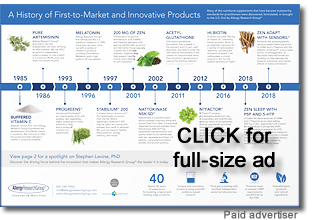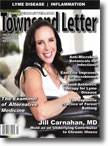|
Page 1, 2, 3
Chronic and complex illnesses are inherently complex and difficult to treat for doctors operating under the modern healthcare system. These illnesses require more thorough medical histories, testing, treatment plans, and patience than many conventional doctors are able to provide due to time, money, and insurance constraints.
Developments in treating complex chronic illnesses are in a constant state of flux as we learn more about infectious and toxic triggers. Thus, doctors choosing to treat patients with chronic conditions must forever be students. Educating ourselves on the most current medical literature and protocols is essential for the success of future treatments.
 Townsend Letter provides a platform for those examining and reporting on functional and integrative medicine. Please support these independent voices. Townsend Letter provides a platform for those examining and reporting on functional and integrative medicine. Please support these independent voices. |
There is no doubt in my mind that this shift from treating symptoms to treating root cause of infectious and environmentally acquired illnesses will only continue to grow. In my personal practice, I'm seeing a rise in conditions such as:
- Chronic inflammatory response syndrome (CIRS),
- Neuroinflammatory conditions,
- Mast cell activation syndrome (MCAS),
- Tick-borne illnesses,
- Viral reactivation and viral load illnesses, and
- All autoimmune diseases.
Moreover, I continue to hear similar patterns from my colleagues. It's not that environmentally acquired illnesses are new, it's that our industrial society is rapidly contributing to the overall toxic burden of the body through new chemicals, plastics, artificial ingredients in the food supply, and cheap construction materials that foster an ideal breeding ground for mold. I often think in terms of total toxic load and infectious burden. Most of these chronic conditions are a complex stew of both of these things.
 The model of care required to successfully treat illnesses like chronic inflammatory response syndrome provides integrative and functional medicine practitioners with a unique opportunity to fill a much-needed gap in today's world of medicine. The model of care required to successfully treat illnesses like chronic inflammatory response syndrome provides integrative and functional medicine practitioners with a unique opportunity to fill a much-needed gap in today's world of medicine.
Specifically, mold-related illnesses have become of particular concern because – depending on the mold species, a person's genetic predisposition, and level of mold exposure – mycotoxins and the other inflammagens and toxins present in a water-damaged building can result in many types of inflammatory responses, including the following:1,2
- Chronic inflammatory response syndrome (CIRS),
- Mycotic infections (mycoses),
- Fungal rhinosinusitis,
- Asthma,
- Pulmonary diseases like hypersensitivity pneumonitis and VOC-induced COPD,
- Mitochondrial toxicity,
- Cytotoxicity/cancer,
- IgE-mediated sensitivity,
- Hypersensitivity pneumonia,
- Carcinogenicity,
- Nephrotoxicity,
- Immune system suppression/dysfunction,
- Abnormalities in T and B cells,
- Central and peripheral neuropathy, and
- Sarcoidosis.
More and more, we are finding how significantly environmental factors can influence disease states. Although, it's not just the environment that plays a role; each person brings their own set of genetics and other variables to the table.
Mycotoxin Mechanisms of Injury
The ways in which mycotoxins impact the body differ greatly based on the person, the mycotoxin, and any other exposures that may be occurring. Here's a brief overview of the different mechanisms of injury from mycotoxins3:
- Infections,
- Allergies,
- Inflammation,
- Autoimmunity,
- Oxidative stress,
- Toxicity,
- Carcinogenicity,
- Synergistic interactions with other bio-contaminants; water-damaged buildings (WDB) nearly always have more than just mycotoxins causing issues (endotoxins, beta glucans, dust, VOCs, etc.).
What Does a Patient Who Has Been Exposed to Mold Look Like?
No two mold patients look exactly the same, which is why case studies are one of the best methods for learning more about mold-related illnesses. (See Sidebar.) That being said, there are some common symptoms:
- Extreme fatigue,
- Weakness,
- Headaches,
- Light sensitivity,
- Brain fog,
- Insomnia,
- Morning stiffness and joint pain,
- Tingling or numbness,
- Shortness of breath,
- Chronic cough or sinus congestion,
- Sugar cravings,
- Metallic taste in mouth,
- Vertigo,
- Static shocks,
- Digestive issues – gas, bloating, heartburn, diarrhea or constipation,
- Blurred vision or red eyes,
- Balance issues,
- Anxiety,
- Depression,
- Skin rashes,
- Urinary incontinence,
- Decrease libido,
- Frequent infections, and
- Chemical intolerance or MCS.
Other common presentations include the following3:
- Seeking multiple practitioners and feel desperate and hopeless,
- Having tried many different treatments with little success,
- Taking multiple medications or intolerance to most medications,
- Normal routine lab work,
- Well appearance, and
- Having been diagnosed with any of the following: chronic fatigue syndrome (ME/CFS), fibromyalgia, depression/anxiety, non-specific rheumatologic disorders, asthma, chronic allergic rhinitis, interstitial cystitis, irritable bowel syndrome, gastroesophageal reflux disease, and/or chemical sensitivity.
Case Study
A 43-year-old male executive found out his condominium was full of black mold. His symptoms included fatigue, brain fog, ice-pick headache, static shocks, and multiple chemical sensitivity.
- Patient Medical History: restless leg syndrome, allergic rhinitis.
- Patient Surgical History: sinoplasty.
- Family History: mother – coronary artery disease; father – diabetes.
- Social: non-smoker, social drinker, no drugs
Pertinent Labs: C4a elevated, TGF Beta elevated, MSH = 10, ADH/Osm abnormal, MMP-9 normal, VEGF normal, anti-gliadin antibodies positive, urinary mycotoxins positive for multiple strains, Visual Contrast Study abnormal, NeuroQuant showed hippocampal atrophy.
Assessment: chronic fatigue syndrome, multiple chemical sensitivity, chronic inflammatory response syndrome
Treatment: Mold avoidance, remediation, liposomal and IV glutathione, binders (including clay, charcoal and cholestyramine), liver support, vitamin D3, B complex, Spore probiotics, multi-mineral supplement, anti-fungal sinus spray, BEG nasal spray, and low-mold diet. |
Common Misconceptions About Mold Patients
Due to the complex nature of mycotoxin illness, many misconceptions have arisen. It's important not to assume any of the following about a patient is true3:
- They must have the HLA susceptible gene to become sick.
- If others in their home or work aren't sick, it can't be mold.
- If their labs are normal, it can't be mold-related illness.
- If they moved and symptoms didn't get better, it can't be mold.
- They don't look sick, so it can't be mold.
- They have multisystem symptoms, and therefore it can't be mold.
Page 1, 2, 3
|
![]()
![]()
![]()
![]()






